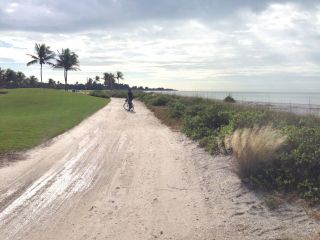Depression
How Can You Exercise Your Depression Away?
Practical recommendations for successfully implementing an exercise program.
Posted August 22, 2014

Exercise doesn't have to be excruciating
When we were kids, my siblings and I would often go down to our Dad’s exercise lab on the weekends. Dad was a cardiologist, an exercise physiologist, and his laboratory was packed with treadmills and bicycle ergometers. Dad would hook us up to the EKG machines and have us breathe into plastic tubes that measured our O2 consumption as we bicycled or ran up imaginary hills. We grew up indoctrinated with the importance of aerobic exercise to prevent heart disease and hypertension and stroke. It seemed obvious that these principles would extend throughout medicine.
So imagine the disconnect when I began psychiatric training and found that exercise played no role whatsoever in the treatment of depression or other psychiatric disorders. In the early 80s at least, psychiatry was practiced in smoke-filled consultation rooms, and was all about the mind, not the body or the brain.
It was only a decade later, in the 1990s, that exercise began to be recognized as possibly helpful for treatment of depression and anxiety disorders. Psychiatrists and psychologists began to occasionally recommend that their patients get more exercise, maybe go for a run a few times a week, or join a gym. It couldn’t hurt, we thought, and maybe it would help--patients who struggled with anxiety, ruminations, physical tension, and the like, might at least feel a bit better if they were able to get outside for some fresh air, or work up a sweat on the elliptical machine. There were even a few studies that showed that depression might improve with regular exercise.
Now, however, a significant body of data has accumulated to show the benefits of exercise--and other ‘complementary’ modalities like yoga and mindfulness meditation--which have increasingly become a part of standard practice.
But it’s still not clear what the best ways are to incorporate these modalities into daily life. For example, with exercise, how much is needed to help with depression? Is it a primary treatment--to replace medication or therapy--or an augmenting one? Who is it best for? And, for people who have depression, what’s the best way for them to start incorporating regular exercise into their lives?
*
In a refreshingly practical 2013 paper in the Journal of Psychiatric Practice, researchers Chad Rethorst and Madhukar Trivedi of the University of Texas Southwestern Medical Center review the literature for exercise just as one would review any medical treatment: including dose, duration, onset of action, possible side effects, toxicities, how it can be combined with other treatments, and for whom it does/doesn’t work. They make recommendations for exercise dosing, exercise prescription that a psychiatrist, psychologist or other mental health worker could provide to a patient--or that people with such disorders can incorporate into their lives.
Below I’ve summarized their recommendations (from this paper and from a recent lecture at the American Psychiatric Association Annual Meeting) in the form of answers to commonly asked questions.
Does exercise help depression?
Basically, the news is encouraging. Exercise is a reasonably good antidepressant, nearly as effective as SSRI antidepressants. It can be an effective treatment in itself. It can help people who only partially improve on SSRI medications to get a better response, and it can prevent the return of depression.
On the other hand, exercise can be hard work. To get the full antidepressant effect of exercise requires exercising at a pretty intense level, and several times per week. Like other treatments, it can take a number of weeks before its full antidepressant effect kicks in. Plus, it can be difficult to motivate oneself to start an exercise program, not to mention to continue it over many weeks and months.
How much exercise is required to get a full antidepressant effect, and how long does it take to work?
The full package of exercise that has been used in most studies is 3 to 5 times per week, for 30 to 60 minutes at a time, and at a fairly high level of intensity, from 50 to 85% of maximal heart rate (220 minus your age in years). Most studies have looked at aerobic exercise (like running or bicycling), but resistance exercise (like weight lifting) may be effective as well. There is some evidence that exercising 45-60 minutes at a time is better than shorter exercise periods.
Similar to other treatments, it takes a while before the full antidepressant effect of exercise kicks in: it can take 4 to 6 weeks to start working, and can achieve maximal effect by around 10 weeks.
How much exercise is necessary to get an antidepressant effect?
In general, more exercise is better than less: for instance in the recent TREAD study, in which exercise was used to augment antidepressant medicine, there were 2 different exercise groups, either at 16 kcal per kg per week (KKW) or 4 KKW of exercise expenditure for 12 weeks. “The dose of 16 KKW was selected on the basis of public health physical activity recommendations and would require walking at ≈ 4.0 mph for 210 minutes per week. The 4-KKW dose is equivalent to walking at 3.0 mph for approximately 75 minutes per week and reflects minimal activity by public health standards.”
In the high-exercise condition, 28% of people had their depression go into remission after 3 months compared to 15% of those in the low-exercise condition.
Similarly in another study by Dunn and colleagues, exercise of higher intensity [17 KKW vs. 7 KKW] was associated with better antidepressant response.
But in general even the lower amount of exercise is associated with some benefit.
Do people stick with such intense exercise programs?
Of people assigned to the higher exercise level in the TREAD study, about two thirds complied. But it can be hard to keep up an exercise program: in the study’s high level exercise group, only about ⅓ of the participants were still meeting the target activity after 3 months!
How intensely should you exercise?
[Of course you should always check with your physician before starting an exercise program to make sure you can tolerate it!]
You have to find a way to measure the intensity of your exercise. Generally the goal is to get to a heart rate of 60 to 85% of 220 minus your age, so target heart rates would be based on age:
Age (years) Target heart rate (beats per minute; BPM)
30 114 to 162
40 108 to 153
50 102 to 145
60 96 to 136
Another way to rate the intensity of your exercise is through what is called the RPE, shorthand for the Borg Rating of Perceived Exertion scale. The range of this scale is from 6 to 20, where 6 is the rating when you’re completely at rest, and 20 when you’re doing the most extreme exercise you’ve ever done. Basically, in the RPE method, rather than measuring heart rate you can estimate how hard you’re exercising--and it turns out the estimate people make is pretty closely correlated to their actual heart rate.
The RPE range is from 6 (at rest) to 20 (maximal exercise). That number, multiplied X 10, is approximately the heart rate for that level of exercise. For instance, if you rate your exercise at a level of 12, your heart rate would be approximately 120 beats per minute. And based on the table above, you could exercise to an intensity level in the middle of the range for your age--say, a level of 14 for a 30 year old, and 12 or 13 for a 50 year old.
How can doctors get patients to increase their activity level?
Rethorst recommends that physicians actually provide a written prescription in order to make exercise a valid part of treatment recommendations. Prescription PDF forms are available at
Exerciseismedicine.org , along with a guide for professionals: http://exerciseismedicine.org/documents/HCPActionGuide_LR.pdf
What about people who have low levels of motivation to start exercising?
Motivational interviewing (MI) can be a helpful way to get people to start changing their behavior patterns. Prochaska and DiClemente identified 5 stages related to people’s readiness to change.
While initially identified for treatment of addiction, they have been widely applied to changing behavior of all kinds, including changes in daily activity. They include: 1. precontemplation; 2. contemplation; 3. preparation; 4. action; 5. maintenance.
During the pre-contemplation phase, before a person realizes exercise may be useful, education is the primary approach. During the contemplation phase, when a person is considering increasing their activity level, the questions become, “what’s stopping you, what has to change in your life to move on to the next step?” During preparation and action phases, the doctor should help to support positive behaviors. For maintenance, encouragement and support are generally necessary for the first 6 months; after that time, such changes tend to stick.
How can people with depression adapt these recommendation to their own situation?
Rethorst recommends setting specific and attainable exercise goals. One option is through “SMART goal setting,” as originally defined by George T. Doran in the world of business management. It includes the following phases:
setting Specific goals
choosing Measures
finding Attainable outcomes
that are also Relevant
being Time-sensitive—setting a target date, for instance, what can I do now? what can I do a month from now? what can I do 3 or 6 months from now?
For each of these items, one should try to identify both barriers to reaching such objectives, and to identify possible solutions, and figure out how confident you are to be able to address them. It helps to set specific times in one’s daily and weekly schedule to incorporate more exercise. Even if full goals can’t be attained, it’s important to keep the principle in mind that ‘some is better than none’!
How should you keep track of your activity?
Some kind of self-monitoring is important. This can include physical activity logs, such as paper or computer calendars or spreadsheets, or web-based fitness tracking services.
Then there are devices, including simple pedometers, or physical activity monitors. These days there’s no shortage of smart-phone based apps that can track activities; since these devices have built-in accelerometers, there’s a wide choice of iPhone and Droid apps to track and record activities.
In addition, there are increasing numbers of armbands, wristbands and other activity-recording devices, such as SenseWear, FitBits, Nike Fuelbands, and the like, that provide real-time feedback which can be reinforcing of increased activity in themselves. Such activity can be shared through social media like Facebook, potentially providing positive group feedbac--as well as the occasional snide comment!
Is some exercise better than none?
Clearly this is the case. There is evidence to suggest that smaller doses of exercise can have positive effects on depression. While the optimal effect of exercise is obtained by exercising 45 minutes to an hour 3 to 5 times per week, as Rethorst and Trivedi put it, “Taken as a whole, ... findings suggest that exercise doses below the current recommendations may still be beneficial for patients with MDD [major depressive disorder]. Therefore, clinicians should encourage patients to engage in at least some exercise, even if they do not exercise enough to meet current public health recommendations.”
Researchers are still struggling with finding ways to increase acceptance of exercise and to improve 'adherence'--that is, getting people to do the program. Having flexible programs may help; also, using a person’s preferred exercise intensity rather than pre-set national recommendations may make it easier for people to stick to exercise regimens.
So, in summary, exercise has been mainstreamed into the treatment of depression and other psychiatric disorders. While a lot more research still remains to be done, we already have many useful tools to help us use exercise to treat depression! We’ve moved a long way from the smoke-filled psychotherapy offices and mental hospitals of the 1970s and 80’s.
Any other suggestions?
Some research suggests that people get more benefit from exercise in natural environments than indoors. So, go for a run in the woods rather than in a windowless gym.
And get yourself outside in the mornings: morning light itself has been shown to have significant antidepressant effects!
* * *




